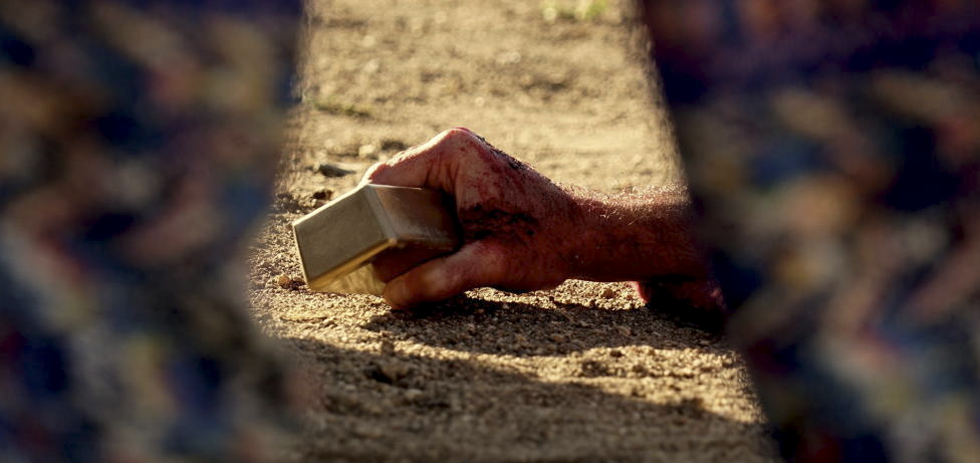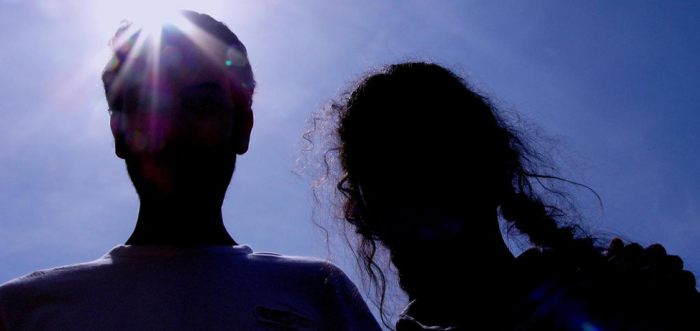Gunshots crack through the Mediterranean stillness; under blazing sunlight, the tension of sex and violence hangs in the air. As with their past work, Hélène Cattet and Bruno Forzani’s heist film Let the Corpses Tan (Laissez bronzer les cadavres) is a film soaked in a distinct atmosphere, yet what ultimately plays out always defies easy description.
They have been making films together since 2001, and their pointed fascination with 1970s exploitation cinema and Italian giallo is evident in everything from their earliest shorts to their feature films, Amer (2009) and The Strange Color of Your Body’s Tears (2013).
Their third feature is narratively closer to a Western or poliziotteschi than a giallo, but the aesthetic sensibilities on show in the earlier work remain. Based on Jean-Patrick Manchette’s 1971 novel of the same name, Let the Corpses Tan is a visual feast. A Corsican free-fire ballet plays out against Bleu-de-France-saturated skies, every shot vibrant and dripping in gold — nothing short of a consistent assault on the senses. It’s only fitting that I interviewed them amidst the hallucinatory neon and clatter of a pinball-themed bar in Melbourne’s CBD.
In your work, how the story is told is just as important as what the story is about. You can’t really divorce the form from the content. It must be difficult to convey those things – the style, the pacing, the editing – in a script. Has that been difficult in terms of securing financing?
Bruno Forzani: This one was easy because it was based on a book. Amer [Cattet and Forzani’s 2009 film] had a nice life, which allowed us to make Strange Colour and Let the Corpses Tan. People grew confident in us — in our style, our way of telling a story, of making something different in the genre area.
Hélène Cattet: But the way we write the scripts is really technical, so it’s not easy to read. It’s not like a novel.
B: Sometimes, for the financing, we write the script more like literature.
H: We have to erase the technical details.
You’ve talked about finding a balance between being loyal to the writer’s vision and infusing Let the Corpses Tan with your own sensibilities. Although this is your first adaptation, I feel like you’ve been doing this for some time – drawing on old styles and themes, for instance, but making them feel contemporary. How do you avoid pastiche?
B: Genre is made by codes. In the Italian Western and the giallo, genre is very linked to mise en scene, so all the codes are in the image, the editing, the sound and the cinematographic tropes. We take that code to tell our own story, not to pay homage. It’s a language. It’s words that help us tell our story. We don’t try to reproduce stories that have been made before. But there is a poetry from this language, these codes, that is very linked to Eros and Thanatos – to sex and death, eroticism and violence. It allowed us to talk about desire, about conflict, about love.
You cast Dominique Troyes, who was a porn star in the ‘70s, as the policewoman whose entrance kickstarts the gunfire. Tell me about that.
B: In the book, Luce and the writer, Bernier, are subversive artists who broke taboos in society, and now they live a bit outcast from society. We wanted to use porn people from the French wave of the ‘70s and ‘80s, because what they’ve done… it’s not like art, but it was a way to make revolution, and to change society, a bit like the artist from the book. We had a good relationship with Marilyn Jess [Dominique Troyes’ stage name], and had seen her several times, originally for the role of Luce.
H: So we wanted her to be part of the movie.
B: It was one year of casting, so we had met her several times, and we did not want to just finish like that.
What was the casting process like for this film, then?
H: For this movie, it was different, because it’s a group. It’s ten or eleven characters. We had to take care of the interactions between everyone, so for the casting, we shot a sequence, and edited this sequence with all the possibilities…
B: Each actor we met. We’d do the same sequence and make several versions of the casting, to see who matches with who.
Like, chemistry?
H: Yeah, like chemistry.
B: So they don’t meet, the actors.
None of them met until you started shooting?
B: Yeah, exactly. ‘Til the dress test.
Speaking of costumes — there is an amazing practical effect that stood out for me. At one moment, a character’s dress is torn apart by bullets. How did you make that happen?
H: It was an organic effect. It was the costume designer, she created a dress, and… I don’t know if I can say the trick.
Oh, it’s a trade secret?
B: Yeah.
H: But it’s a really old-fashioned trick.
This film has an aversion to the digital, or the artificial, in many ways. There’s these practical effects; they’re stealing gold, this very tangible, natural thing; and you’re shooting on 16mm film. Why was shooting on film important to you?
B: The texture [of 16mm] allows us to create a timeless universe — to make it tangible; real, even if it’s fake. If we imagine Let the Corpses Tan shot on digital, with all this blue, this sun, and things like that, it would be like a carnival, not something really credible. You wouldn’t believe the universe.
H: We need the grain of the film to finish the retro atmosphere. Digital is cold.
B: Movies are very chemical. They are like drugs. I think, if it’s in digital, it’s not the same thing.

Were you working on Let the Corpses Tan with a sense of time and place in mind? It feels a bit dreamlike.
B: I come from the south of France, the French Riviera, and all these Mediterranean settings are very nostalgic for me. A kind of Madeleine de Proust — something from your childhood that you like to taste again; to revisit. It’s not just about fashion or things like that, it’s something more real, deep inside me.
H: When we see an old movie from the ‘70s, we are thinking about our childhood, our family movies, things like that. It’s our sensibility.
In one of the festival Q&As, you mentioned that you shot the whole thing without sound, and then built the entire soundtrack through foley afterwards. Did you always know you wanted to shoot it like that?
H: Yeah.
B: When we began to shoot our short films, we didn’t have any money, and we wanted to shoot on film, so we shot with slides, and when you shoot with slides, you can’t have direct sound. So we got used to working that way. And we realized that on set it was more efficient, if you want to make a lot of shots per day, to work without sound.
H: But it’s six months of work on the sound.
There’s a real sense of knowing what you’re making in the films. I’m interested in how these ideas come to you, and how you work together as a duo to arrive on things.
H: It’s like a tennis game. One begins to write the script, gives the other a draft, and the other jumps on the idea and makes another draft.
B: But it’s always on the edge of the razor, because you never know if it will work or not. Each time, you are attracted by the physical thing — the world, a room, a light. It’s complicated to create them, because we do it all organically, not with CGI, so we have to believe in each idea.
Luce is a secondary character in the book, and you’ve made her much more prominent in the film. How did you come to that decision?
H: It was one of the first ideas, when we began to write. The character fascinated us, because she was shooting on paintings. It reminded us of Niki de Saint Phalle, a French artist from the movement of nouveau réalisme — a very interesting movement from the ’60s, a movement of destruction and performance.
B: We thought it would be a good way to approach gunfights and things like that — to be more like a performance. More than doing something like Sergio Leone or John Woo. It was a way to approach action. The book was also a very male universe, and to have this character who is not like a female Jason Bourne… sometimes, in American blockbusters, you have a female character in an action movie, but it’s like a replica of the male one. Here she had a special status. It’s totally different. She’s stronger than just an action man.
H: Yeah. She has her own universe.
